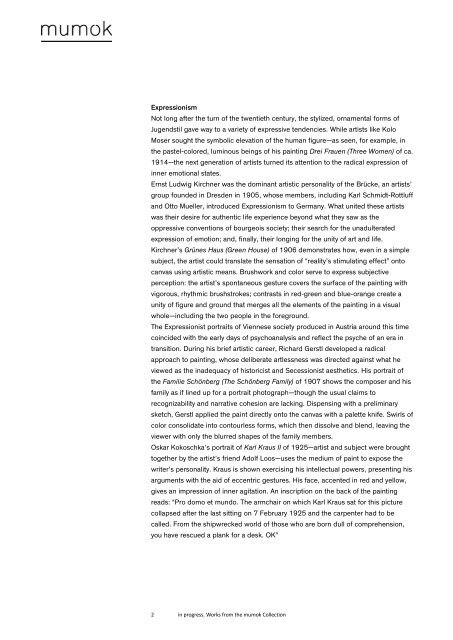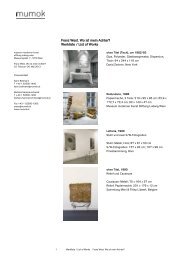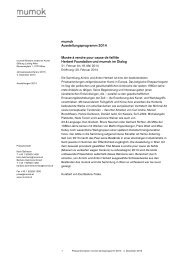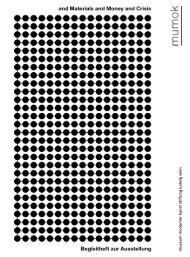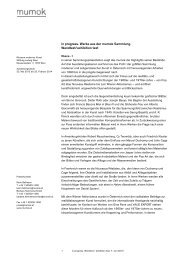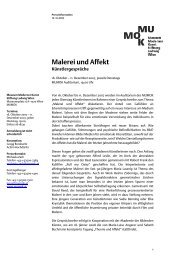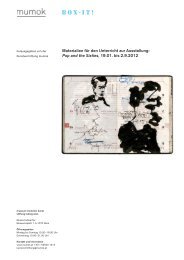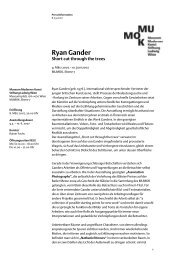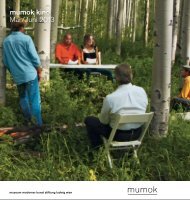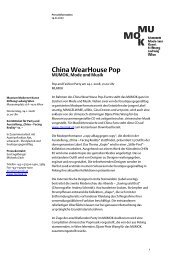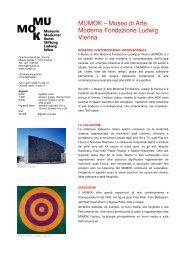Detailed information about the exhibition (212 KB) - Mumok
Detailed information about the exhibition (212 KB) - Mumok
Detailed information about the exhibition (212 KB) - Mumok
You also want an ePaper? Increase the reach of your titles
YUMPU automatically turns print PDFs into web optimized ePapers that Google loves.
Expressionism<br />
Not long after <strong>the</strong> turn of <strong>the</strong> twentieth century, <strong>the</strong> stylized, ornamental forms of<br />
Jugendstil gave way to a variety of expressive tendencies. While artists like Kolo<br />
Moser sought <strong>the</strong> symbolic elevation of <strong>the</strong> human figure—as seen, for example, in<br />
<strong>the</strong> pastel-colored, luminous beings of his painting Drei Frauen (Three Women) of ca.<br />
1914—<strong>the</strong> next generation of artists turned its attention to <strong>the</strong> radical expression of<br />
inner emotional states.<br />
Ernst Ludwig Kirchner was <strong>the</strong> dominant artistic personality of <strong>the</strong> Brücke, an artists’<br />
group founded in Dresden in 1905, whose members, including Karl Schmidt-Rottluff<br />
and Otto Mueller, introduced Expressionism to Germany. What united <strong>the</strong>se artists<br />
was <strong>the</strong>ir desire for au<strong>the</strong>ntic life experience beyond what <strong>the</strong>y saw as <strong>the</strong><br />
oppressive conventions of bourgeois society; <strong>the</strong>ir search for <strong>the</strong> unadulterated<br />
expression of emotion; and, finally, <strong>the</strong>ir longing for <strong>the</strong> unity of art and life.<br />
Kirchner’s Grünes Haus (Green House) of 1906 demonstrates how, even in a simple<br />
subject, <strong>the</strong> artist could translate <strong>the</strong> sensation of “reality’s stimulating effect” onto<br />
canvas using artistic means. Brushwork and color serve to express subjective<br />
perception: <strong>the</strong> artist’s spontaneous gesture covers <strong>the</strong> surface of <strong>the</strong> painting with<br />
vigorous, rhythmic brushstrokes; contrasts in red-green and blue-orange create a<br />
unity of figure and ground that merges all <strong>the</strong> elements of <strong>the</strong> painting in a visual<br />
whole—including <strong>the</strong> two people in <strong>the</strong> foreground.<br />
The Expressionist portraits of Viennese society produced in Austria around this time<br />
coincided with <strong>the</strong> early days of psychoanalysis and reflect <strong>the</strong> psyche of an era in<br />
transition. During his brief artistic career, Richard Gerstl developed a radical<br />
approach to painting, whose deliberate artlessness was directed against what he<br />
viewed as <strong>the</strong> inadequacy of historicist and Secessionist aes<strong>the</strong>tics. His portrait of<br />
<strong>the</strong> Familie Schönberg (The Schönberg Family) of 1907 shows <strong>the</strong> composer and his<br />
family as if lined up for a portrait photograph—though <strong>the</strong> usual claims to<br />
recognizability and narrative cohesion are lacking. Dispensing with a preliminary<br />
sketch, Gerstl applied <strong>the</strong> paint directly onto <strong>the</strong> canvas with a palette knife. Swirls of<br />
color consolidate into contourless forms, which <strong>the</strong>n dissolve and blend, leaving <strong>the</strong><br />
viewer with only <strong>the</strong> blurred shapes of <strong>the</strong> family members.<br />
Oskar Kokoschka’s portrait of Karl Kraus II of 1925—artist and subject were brought<br />
toge<strong>the</strong>r by <strong>the</strong> artist’s friend Adolf Loos—uses <strong>the</strong> medium of paint to expose <strong>the</strong><br />
writer’s personality. Kraus is shown exercising his intellectual powers, presenting his<br />
arguments with <strong>the</strong> aid of eccentric gestures. His face, accented in red and yellow,<br />
gives an impression of inner agitation. An inscription on <strong>the</strong> back of <strong>the</strong> painting<br />
reads: “Pro domo et mundo. The armchair on which Karl Kraus sat for this picture<br />
collapsed after <strong>the</strong> last sitting on 7 February 1925 and <strong>the</strong> carpenter had to be<br />
called. From <strong>the</strong> shipwrecked world of those who are born dull of comprehension,<br />
you have rescued a plank for a desk. OK”<br />
2 in progress. Works from <strong>the</strong> mumok Collection


